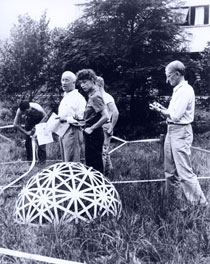Starting at Zero
dal 27/1/2006 al 1/4/2006
Segnalato da
Josef and Anni Albers
Lyonel Feininger
Willem and Elaine de Kooning
Franz Kline
Robert Motherwell
Kenneth Noland
Robert Rauschenberg
Cy Twombly
Ben Shahn
Ray Johnson
John Cage
Merce Cunningham
Buckminster Fuller
Bernard Leach
Shoji Hamada
Aaron Siskind
Harry Callahan
Charles Olson
Robert Creeley
27/1/2006
Starting at Zero
Kettle's Yard, Cambridge
Black Mountain College 1933-57. Group show. Through paintings and sculpture, ceramics and weavings, photographs and film, musical scores and contemporary documents, the show highlights some of the extraordinary coincidences and collaborations which happened at Black Mountain. It was the place where, in 1948, Buckminster Fuller first demonstrated his geodesic dome, helped by Elaine de Kooning and Ray Johnson.

Black Mountain College 1933-57
Black Mountain College was a utopian dream, born out of the Depression and
the rise of Fascism in Europe. Starting at Zero: Black Mountain College
1933-57 is the first UK exhibition of one of the most exciting experiments
in the arts, education and community of the 20th century.
Through paintings and sculpture, ceramics and weavings, photographs and
film, musical scores and contemporary documents, the exhibition highlights
some of the extraordinary coincidences and collaborations which happened at
Black Mountain. It was the place where, in 1948, Buckminster Fuller first
demonstrated his geodesic dome, helped by Elaine de Kooning and the young
Ray Johnson. In the evenings they joined up with John Cage and Merce
Cunningham in a production of Erik Satie's The Ruse of the Medusa, directed
by Arthur Penn, with sets by Willem de Kooning. Four years later John Cage,
Merce Cunningham and Robert Rauschenberg joined forces to create the first
happening'. The final years saw Charles Olson gathering together Robert
Creeley, Jonathan Williams, Ed Dorn and others who became celebrated as the
Black Mountain poets.
Founded in North Carolina in 1933 by John Andrew Rice, a dissident
Classical academic, it attracted a star-studded cast of teachers and
students who forged a dramatic shift from a European art world to a
distinctly American one. Rice invited Josef and Anni Albers to join the
faculty after Hitler had closed the Bauhaus and Josef Albers became the
College¹s guiding light for its first fifteen years. Albers and Rice
encouraged education through experiment, the experience of doing, rather
than simply absorbing information. Faculty members were asked to teach out
of their own enthusiasms and students were encouraged to build their own
syllabuses.
The Albers' insistence on starting at zero' struck a chord not only with
abstract expressionists like Willem de Kooning, Robert Motherwell and Franz
Kline, but also with Buckminster Fuller's visionary reinvention of
architecture, John Cage's abandonment of musical harmony for simple
duration and rhythm, and Robert Rauschenberg's first white and black
paintings. For the Albers as for their successor, Charles Olson, it meant,
in part, looking back from a modern world to Pre-Columbian Mexico. But
while Albers saw simplicity as a social obligation, in post-war years
Buckminster Fuller, with an equally strong social agenda, wanted to
encompass everything I know', and Olson urged students to take on the
whole of knowledge'.
Artists: Josef and Anni Albers, Lyonel Feininger,
Willem and Elaine de Kooning, Franz Kline, Robert Motherwell, Kenneth
Noland, Robert Rauschenberg, Cy Twombly, Ben Shahn, Ray Johnson, John Cage,
Merce Cunningham, Buckminster Fuller, Bernard Leach and Shoji Hamada, Aaron
Siskind and Harry Callahan, Charles Olson and Robert Creeley.
The exhibition, organised by Kettle's Yard and Arnolfini, Bristol is
accompanied by a substantial catalogue including essays by Christopher
Benfey, Eva Diaz, Mary Emma Harris, Jed Perl and Edmund de Waal, and
extensive programmes of events.
Starting at Zero: Black Mountain College 1933-57 is supported by Arts
Council England and The Henry Moore Foundation. Its accompanying programme
is supported by NESTA
Kettle's Yard
Castle Street - Cambridge



